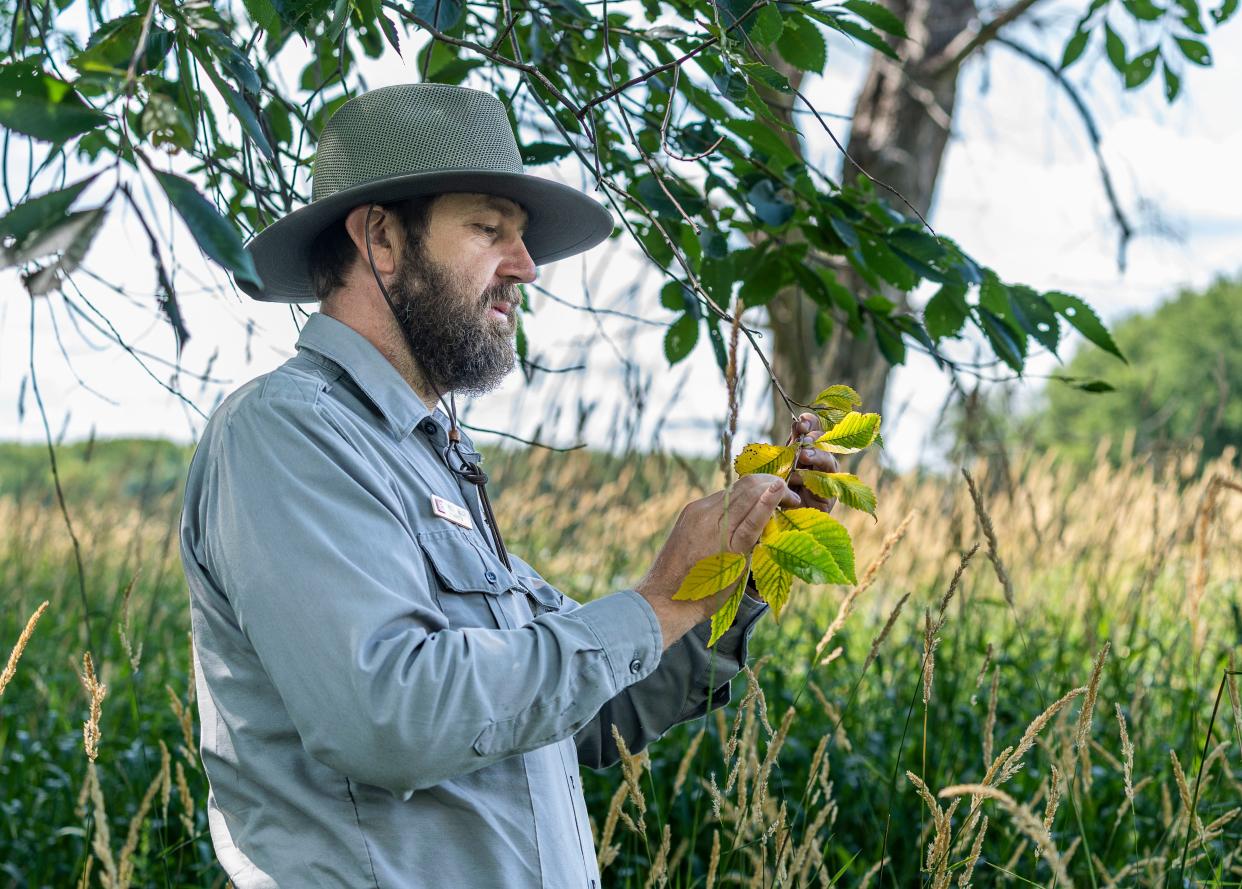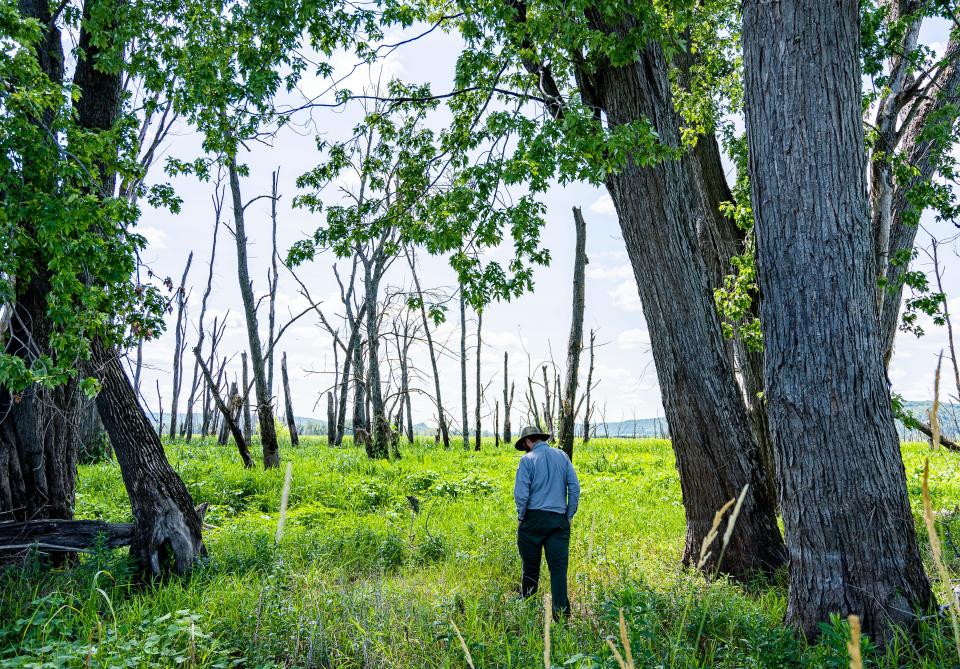Dutch elm disease came first. Then emerald ash borer. Now, an urgent push is on to restore trees.

RENO BOTTOMS - The elm tree that towered over Andy Meier was a survivor.
At 37 inches around and about 150 years old, it had so far avoided Dutch elm disease, the fungus that wiped out many of its neighbors growing along the upper Mississippi River. Meier, a U.S. Army Corps of Engineers forester based in the La Crosse area, pointed to another elm close by that had fallen victim — proof that the disease had been in the area and left this tree unscathed.
Or so he thought.
"This one leaf here is a little concerning," he said, pulling on a low-hanging branch on which a leaf had turned pale yellow — the fungus's first warning sign. It could have been just a thirsty tree showing signs of a dry summer, but he'd have to return next year to find out for sure.
Dutch elm disease was first discovered in the U.S. in the 1930s and swept through the country in waves in the decades that followed. It's been tough on the forests of the upper Mississippi River floodplain, because elms used to have a foundational role in the tree canopy, providing shade for the understory and the wildlife that lives within it.
Today, those floodplain forests are struggling against a multitude of threats: excessive flooding, invasive grasses and the destruction wrought by the emerald ash borer, all while Dutch elm continues to strike.
More: The Mississippi River's floodplain forests are dying. The race is on to bring them back.
But a research project from the U.S. Forest Service could turn the future of elm trees around. The agency is seeking survivor trees, ones that have lasted decades in the forest, to take buds from and produce copies. Those trees could hold some genetic secret to resisting the disease, and those copies, then, could help them repopulate.
"If we could bring elm back into this landscape ... it would really change things a lot for us," Meier said.
'Survivor elms' could be key to bringing the species back
Elm trees used to be a significant component of floodplain forest communities. Their seeds ripen in late spring, when few other seeds are available for hungry birds and other animals. They're also a host for a variety of caterpillar species. And their wood holds up well against flooding, which happens every year.
As such, Dutch elm disease has wreaked havoc, particularly on American elm trees. In Wisconsin, two-thirds of large American elms growing on timberland were wiped out between 1983 and 2021, according to data from the Forest Service's Forest Inventory and Analysis program. The species itself isn't in danger of extinction — the number of total elms in Wisconsin has increased from roughly 192 million to 244 million in that time frame — but the trees are killed before they're old enough to perform their traditional ecological role.
The disease spreads from tree to tree by way of an insect, the elm bark beetle, or through the roots of trees growing close together. The fungus enters the vascular tissue of a tree, creating blockages so the tree can't take up water, which eventually causes it to wilt and die. In some cases, that can happen in weeks.
So what allows the survivor trees to resist? It's a bit of a mystery, but it's likely that they have the ability to wall off the infected area and prevent it from reaching the entire tree, said Linda Haugen, a forest pathologist for the Forest Service.
Haugen is coordinating the project that aims to restore elm trees. In the past year, Army Corps and Forest Service staff collected buds from 18 large, surviving elms. In all, Meier said, the Corps has identified between 50 and 60 elms that are bigger than 24 inches around and thus likely to be survivors — including the one with the yellowing leaf. (Even if it ends up dying, he said, it still survived for a long time and could hold some answers.)

Those 18 buds were sent to a Forest Service greenhouse to be grafted — in other words, attached to another elm seedling so that seedling grows up with the genetic material from the surviving tree. Once the seedling starts to grow, Forest Service staff will cut off shoots and repot those to create copies of the trees that have their own root systems.
Once enough of those cloned trees exist, researchers will inject Dutch elm disease into them. That will determine if they're really resistant, or if the original tree was just lucky, Haugen said. The final step is to plant survivors out in the real world, where they can produce seeds that are likely to grow into healthy, long-living elms.
"(Our) end goal is to be able to provide elms ... that will be able to survive and persist on the landscape, so (they) can reclaim that ecological role of surviving to be the big trees," she said.
The elms on the upper Mississippi are part of a national effort by the Forest Service to restore these trees. Two years earlier, Haugen said, they began the same process using a group of American elm trees growing in the Chippewa National Forest in northern Minnesota, which not only are potentially resistant to Dutch elm disease but are also able to withstand cold temperatures.
The urgency of reviving elm trees has been hastened by the emerald ash borer's devastation of ash trees, Haugen said, because a forest needs to have several tree species to be resilient. The forests along the upper Mississippi, for example, were traditionally maple-ash-elm forests. If the ash borer wipes out those trees, it leaves the entire ecosystem vulnerable if a maple tree disease were to come along.
Like any work that involves trees, though, it isn't going to happen quickly. It will take seven to 10 years before the cloned trees are ready to be subjected to the fungus, Haugen said, and another seven to 10 years after that they'd start producing seeds.
For land managers that are antsy to start forest restoration, that's a long time to wait. In the meantime, they can use seeds from the survivor trees to plant more elms, she said.
But only time will tell what the secret to survivorship may be.
Madeline Heim is a Report for America corps reporter who writes about environmental issues in the Mississippi River watershed and across Wisconsin. Contact her at 920-996-7266 or mheim@gannett.com.
Please consider supporting journalism that informs our democracy with a tax-deductible gift to this reporting effort at jsonline.com/RFA or by check made out to The GroundTruth Project with subject line Report for America Milwaukee Journal Sentinel Campaign. Address: The GroundTruth Project, Lockbox Services, 9450 SW Gemini Dr, PMB 46837, Beaverton, Oregon 97008-7105.
This article originally appeared on Milwaukee Journal Sentinel: Upper Mississippi part of larger U.S. effort to restore lost trees

